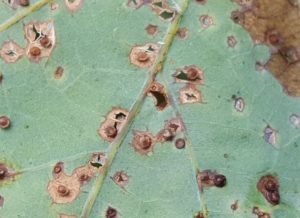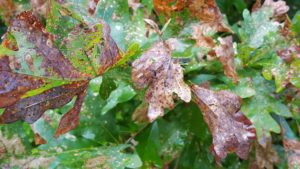
Brown areas on these white oak leaves were caused by a heavy infestation of jumping oak gall.

Jumping oak galls caused by tiny wasps form on the underside of white oak leaves.
If you were in Waupaca County this summer, you probably noticed that large white oaks were looking pretty brown. They were being defoliated by a tiny gall wasp called jumping oak gall (Neuroterus saltatorius). The small galls, which develop around tiny larvae on the undersides of oak leaves, fall off the leaves in late summer.
The galls, with their tiny larvae, drop to the ground where the larvae begin to move, making the galls appear to jump. This motion allows galls to move deeper into the leaf litter or the soil where they will spend the winter. Adult gall wasps will emerge next spring and start the cycle over again. Although some of the trees looked bad this year, one year of defoliation should not kill the tree. It is typical for the population to remain high for a couple of years before natural enemies catch up and get it under control. Missouri’s Department of Conservation has a helpful fact sheet if you’re interested in learning more about this tiny stingless wasp.
Written by: Linda Williams, forest health specialist, Woodruff, (Linda.Williams@wisconsin.gov), 715-356-5211 x232.
